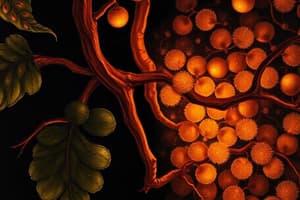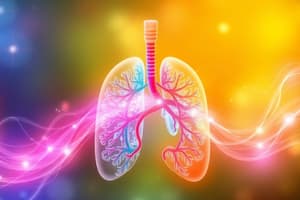Podcast
Questions and Answers
What is the primary purpose of respiration in living cells?
What is the primary purpose of respiration in living cells?
- To create carbon dioxide
- To produce oxygen
- To release energy from glucose (correct)
- To absorb water
What is the function of gas exchange in organisms?
What is the function of gas exchange in organisms?
- To obtain oxygen and remove carbon dioxide (correct)
- To release energy
- To store water
- To produce glucose
What is required for aerobic respiration to occur?
What is required for aerobic respiration to occur?
- Oxygen (correct)
- Carbon dioxide
- Water
- Nitrogen
In aerobic respiration, glucose is broken down into what products?
In aerobic respiration, glucose is broken down into what products?
What is the main energy-carrying molecule produced during aerobic respiration?
What is the main energy-carrying molecule produced during aerobic respiration?
What is NOT required for anaerobic respiration?
What is NOT required for anaerobic respiration?
What product is formed from anaerobic respiration in animal cells?
What product is formed from anaerobic respiration in animal cells?
What products are formed from anaerobic respiration in yeast?
What products are formed from anaerobic respiration in yeast?
What is meant by the term 'oxygen debt'?
What is meant by the term 'oxygen debt'?
Which part of the human gas exchange system splits into two bronchi?
Which part of the human gas exchange system splits into two bronchi?
What are the tiny air sacs in the lungs where gas exchange occurs?
What are the tiny air sacs in the lungs where gas exchange occurs?
What happens to the diaphragm during inspiration?
What happens to the diaphragm during inspiration?
What happens to the rib cage during expiration?
What happens to the rib cage during expiration?
Why do alveoli have thin walls?
Why do alveoli have thin walls?
What structures do fish use for gas exchange?
What structures do fish use for gas exchange?
What is the name of the flap that covers and protects the gills in fish?
What is the name of the flap that covers and protects the gills in fish?
What structures are the primary sites of gas exchange in plants?
What structures are the primary sites of gas exchange in plants?
What is the role of guard cells in plants?
What is the role of guard cells in plants?
Which of the following increases the rate of gas exchange?
Which of the following increases the rate of gas exchange?
What is a chronic respiratory disease that causes inflammation and narrowing of the airways?
What is a chronic respiratory disease that causes inflammation and narrowing of the airways?
Flashcards
Respiration
Respiration
A chemical process in cells that releases energy from glucose.
Gas Exchange
Gas Exchange
Process of obtaining oxygen and removing carbon dioxide.
Aerobic Respiration
Aerobic Respiration
Respiration using oxygen to break down glucose into carbon dioxide and water, releasing much energy.
Anaerobic Respiration
Anaerobic Respiration
Signup and view all the flashcards
Oxygen Debt
Oxygen Debt
Signup and view all the flashcards
Human Gas Exchange System
Human Gas Exchange System
Signup and view all the flashcards
Alveoli
Alveoli
Signup and view all the flashcards
Ventilation
Ventilation
Signup and view all the flashcards
Inspiration (Inhalation)
Inspiration (Inhalation)
Signup and view all the flashcards
Expiration (Exhalation)
Expiration (Exhalation)
Signup and view all the flashcards
Alveoli Adaptations
Alveoli Adaptations
Signup and view all the flashcards
Gills
Gills
Signup and view all the flashcards
Gill Filaments and Lamellae
Gill Filaments and Lamellae
Signup and view all the flashcards
Countercurrent Flow
Countercurrent Flow
Signup and view all the flashcards
Stomata
Stomata
Signup and view all the flashcards
Guard Cells
Guard Cells
Signup and view all the flashcards
Lenticels
Lenticels
Signup and view all the flashcards
Temperature Effect
Temperature Effect
Signup and view all the flashcards
Asthma
Asthma
Signup and view all the flashcards
Emphysema
Emphysema
Signup and view all the flashcards
Study Notes
- Respiration is a chemical process in all living cells releasing energy from glucose.
- Gas exchange involves obtaining oxygen from the environment and removing carbon dioxide.
Aerobic Respiration
- Aerobic respiration requires oxygen.
- Glucose breaks down into carbon dioxide and water.
- A large amount of energy is released.
- Word equation: Glucose + Oxygen → Carbon Dioxide + Water (+ Energy).
- Balanced chemical equation: C6H12O6 + 6O2 → 6CO2 + 6H2O (+ Energy).
- Most energy released is in the form of ATP (adenosine triphosphate).
Anaerobic Respiration
- Anaerobic respiration doesn't require oxygen.
- Glucose breaks down into different products depending on the organism.
- In animals, glucose converts to lactic acid, releasing a small amount of energy.
- Word equation (animals): Glucose → Lactic Acid (+ Energy).
- In yeast and some plants, glucose converts to ethanol and carbon dioxide.
- Word equation (yeast): Glucose → Ethanol + Carbon Dioxide (+ Energy).
- Anaerobic respiration is less efficient than aerobic respiration.
- It yields less energy per glucose molecule.
- Oxygen debt is the additional oxygen needed after anaerobic respiration.
- It breaks down accumulated lactic acid.
Gas Exchange in Humans
- The human gas exchange system includes lungs, trachea, bronchi, bronchioles, alveoli, and diaphragm.
- Air enters through the nose and mouth.
- Air passes through the trachea, splitting into two bronchi.
- Each bronchus branches into bronchioles, ending in alveoli.
- Alveoli are the primary site of gas exchange in the lungs.
- Lungs are located in the chest cavity.
- The rib cage protects the lungs.
- Ventilation is the process of moving air in and out of the lungs.
- It consists of inspiration (inhalation) and expiration (exhalation).
Inspiration (Inhalation)
- During inspiration, the diaphragm contracts and moves downwards.
- Intercostal muscles contract, lifting the rib cage up and outwards.
- These movements increase the chest cavity volume.
- This decreases the air pressure inside the lungs.
- Air flows into the lungs from the atmosphere due to the pressure gradient.
- Air flows in until the pressure inside the lungs equals atmospheric pressure.
Expiration (Exhalation)
- During expiration, the diaphragm relaxes and moves upwards.
- Intercostal muscles relax, lowering the rib cage down and inwards.
- These movements decrease the volume of the chest cavity.
- This increases the air pressure inside the lungs.
- Air flows out of the lungs into the atmosphere due to the pressure gradient.
- Air flows out until the pressure inside the lungs equals atmospheric pressure.
Alveoli
- Alveoli are tiny air sacs in the lungs where gas exchange occurs.
- Alveoli have thin walls (one cell thick) to minimize diffusion distance.
- Alveoli have a large surface area to maximize gas exchange rate.
- Alveoli are surrounded by a dense network of capillaries.
- This ensures a constant blood supply for gas exchange.
- The concentration gradient between the air in the alveoli and the blood in the capillaries drives the diffusion of oxygen and carbon dioxide.
- Oxygen diffuses from the air in the alveoli into the blood.
- Oxygen binds to hemoglobin in red blood cells.
- Carbon dioxide diffuses from the blood into the air in the alveoli to be exhaled.
- The alveolar epithelium is moist.
- Allowing gases to dissolve and diffuse more efficiently.
Gas Exchange in Fish
- Fish use gills for gas exchange.
- Gills are on either side of the head.
- Gills consist of gill filaments and gill lamellae.
- Gill filaments are thin, highly folded structures.
- They increase the surface area for gas exchange.
- Gill lamellae are even smaller structures on the gill filaments.
- They further increase the surface area.
- Water flows over the gills in one direction.
- Blood flows through the gill lamellae in the opposite direction (countercurrent flow).
- Countercurrent flow maintains a concentration gradient.
- It maximizes oxygen uptake from the water.
- As water flows over the gills, oxygen diffuses from the water into the blood.
- Carbon dioxide diffuses from the blood into the water.
- The operculum is a bony flap.
- It covers and protects the gills.
- It helps pump water over the gills.
- Fish ventilate their gills by opening and closing their mouth and operculum in a coordinated manner.
Gas Exchange in Plants
- Gas exchange in plants occurs primarily through stomata.
- Stomata are small pores on the surface of leaves.
- Stomata are surrounded by guard cells.
- Guard cells regulate the opening and closing of the stomata.
- During the day, stomata open.
- This allows carbon dioxide to enter for photosynthesis.
- This allows oxygen to exit as a byproduct.
- At night, stomata usually close.
- This reduces water loss through transpiration.
- Gas exchange also occurs through lenticels.
- Lenticels are small pores on the stems and roots of plants.
- Lenticels allow for the exchange of oxygen and carbon dioxide between the plant tissues and the environment.
- The rate of gas exchange in plants is affected by light intensity, temperature, and humidity.
Factors Affecting Respiration and Gas Exchange
- Temperature: Higher temperatures generally increase the rate of respiration and gas exchange, up to a certain point.
- Oxygen concentration: Higher oxygen concentrations increase the rate of aerobic respiration.
- Carbon dioxide concentration: Higher carbon dioxide concentrations can decrease the rate of respiration in some organisms.
- Surface area: Larger surface areas for gas exchange increase the rate of diffusion.
- Diffusion distance: Shorter diffusion distances increase the rate of gas exchange.
- Ventilation rate: Higher ventilation rates increase the rate of gas exchange by maintaining a concentration gradient.
- Metabolic rate: Higher metabolic rates increase the demand for oxygen and the production of carbon dioxide, affecting respiration and gas exchange.
Health Issues
- Asthma: A chronic respiratory disease.
- It causes inflammation and narrowing of the airways.
- This makes it difficult to breathe.
- Bronchitis: Inflammation of the bronchi.
- Often caused by infection or irritants.
- Leads to coughing and mucus production.
- Emphysema: A lung disease in which the alveoli are damaged.
- This reduces the surface area for gas exchange.
- Pneumonia: An infection of the lungs.
- It causes inflammation and fluid buildup in the alveoli.
- Cystic Fibrosis: A genetic disorder.
- It causes the production of thick mucus.
- This can block the airways and lead to lung infections.
Studying That Suits You
Use AI to generate personalized quizzes and flashcards to suit your learning preferences.




